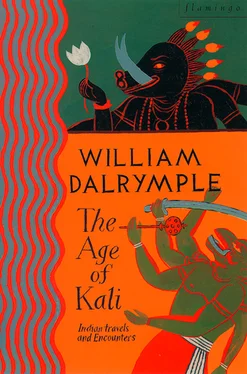1 ...7 8 9 11 12 13 ...22 Nevertheless, the best of the buildings in Lucknow – those that date from the late eighteenth century – are evidence of a remarkable silver age which in sheer exuberance has no equal in India. The Great Imambara complex was constructed by Asaf ud-Daula for Shi’ite religious discourses in 1784. One of the largest vaulted halls in the world, it was built in order to create employment during a famine. Here there is none of the camp doodling that would be seen on later Nawabi buildings. Instead the Imambara is a vast and thoroughly monumental building: long, echoing arcades of cusped arches rise to great gilded onion-domes and rippling lines of pepperpot semi-domes; at the corners soaring minarets culminate in solid, well-designed chattris. The whole composition surrounded by the Great Mosque and the Rumi Darwaza exudes a bold, reckless and extravagant self-confidence. Lucknow was consciously aiming to surpass the glories of late-Moghul Delhi, and the Great Imambara shows it could do so with dashing panache.
Driving today through the melancholic streets of modern Lucknow, the massive buildings dating from the days of the Nawabs rear out of the surrounding anarchy like monuments from some lost civilisation, seemingly as disconnected from the present as the pyramids are from modern Egypt. At times it seems almost impossible to believe that they date from less than two hundred years ago, and that at that period Lucknow was famed as one of the richest kingdoms in Asia. For today the city is as shabby and impoverished as anywhere in India. Waves of squabbling cycle-rickshaw drivers pass down the potholed roads, bumping in and out of the puddles. Rubbish lies uncollected by the roadside, with dogs competing with rats to snuffle in the piles of garbage. Beside them, lines of desperate street-vendors squat on dirty rush-mats, displaying their tawdry collections of cheap plastic keyrings and fake Rolex watches. There is no grass in the parks and no flowers in the beds; barbed wire hangs limply around what were once beautiful Moghul gardens alive with the sound of parakeets and peacocks. Above the crumbling ruins of the old city of the Nawabs rise the monsoon-stained tower-blocks erected since Independence, and now, like the ruins, showing signs of imminent collapse, with deep fissures running up their sides.
The contrast between the magnificent follies of the Nawabs and the decayed, impoverished post-colonial intrusions which stand among them is almost unbearably painful: everywhere, it seems, there has been a universal drop in standards and expectations.
Yet even as the greatest buildings of Nawabi Lucknow were being erected, the Kingdom of Avadh was acutely conscious that it was living on borrowed time. In 1764, before the Nawabs had even established their capital at Lucknow, their armies had already been defeated in battle by the East India Company, and over the course of the early nineteenth century the Company ate like a cancer in to the territories of Avadh: in less than fifty years the British annexed more than half the kingdom. But the Nawabs remained surprisingly well disposed towards Europeans, and delighted in the trinkets and amusements Westerners could provide for their court: European jugglers, portrait painters, watch-menders, piano tuners and even fashionable London barbers were all welcomed to Lucknow, and were well paid for their services.
If the Nawab sometimes amazed foreign visitors by appearing dressed as a British admiral, or even as a clergyman of the Church of England, the Europeans of Lucknow often returned the compliment. Miniature after miniature from late-eighteenth-century Lucknow shows Europeans of the period dressed in long white Avadhi gowns, lying back on carpets, hubble-bubbles in their mouths, as they watch their nautch girls dance before them. Even those who never gave up European dress seem to have taken on the mores of Nawabi society: Major General Claude Martin, for example, kept a harem which included his favourite wife Boulone as well as her three sisters. Nor was this sexual curiosity one-way: at least two British memsahibs were recruited to join the royal Avadhi harem, and a mosque survives which was built by the Nawab for one of them, a Miss Walters.
Much of the surviving architecture of the city reflects this unique moment of Indo-European intermingling. Constantia, Claude Martin’s great palace-mausoleum, now the La Martiniere school, is perhaps the most gloriously hybrid building in India, part Nawabi fantasy and part Gothic colonial barracks. Just as Martin himself combined the lifestyle of a Muslim prince with the interests of a renaissance man – writing Persian couplets and maintaining an observatory, experimenting with map-making and botany, hot-air balloons and even bladder surgery – so his mausoleum mixes Georgian colonnades with the loopholes and turrets of a medieval castle; Palladian arcades rise to Moghul cupolas; inside, brightly-coloured Nawabi plasterwork encloses Wedgwood plaques of classical European gods and goddesses.
For while Martin designed Constantia to be the most magnificent European funerary monument in India, the East India Company’s answer to the Taj Mahal, it was also intended to be defensible. The eighteenth century was an anarchic and violent time in India, and during an uprising in the 1770s Martin had to defend his residence with a pair of cannon filled with grapeshot. It was a lesson he never forgot, and he built Constantia to be his last redoubt in case of danger. Lines of cannon crowned the façade, and thick iron doors sealed off the narrow spiral staircases which connected the various ‘bomb-proof’ floors. On the façade Martin erected two colossal East India Company lions which were designed to hold flaming torches in their mouths. The sight of these illuminated beasts belching out fire and smoke on a dark night was intended to terrify would-be intruders.
In its wilful extravagance and sheer strangeness, Constantia embodies like no other building the opulence, restlessness and open-mindedness of this city on the faultline between East and West, the old world of the Nawabs and the new world of the Raj. To this day the whole extraordinary creation stands quite intact, still enclosed in acres of its own parkland. As you approach on your rickshaw you proceed along a superb avenue of poplar and tamarind, eucalyptus and casuarina, at the end of which you pass the perfect domed Moghul tomb which Martin built for his beloved Boulone. As he rather touchingly wrote in his will: ‘She choosed never to quit me. She persisted that she would live with me, and since we lived together we never had a word of bad humour one against another.’
Not far from Constantia, a short rickshaw ride over the railway crossing, I stumbled across a smaller but equally remarkable building from the same period. It turned out to be the ruins of one of the Nawabs’ most lovely pleasure palaces, named Dilkusha, or Heart’s Delight. Yet despite this very Persian name, Dilkusha was in fact closely modelled on one of the great English country houses, Seaton Delaval in Northumberland – but with four gloriously ornate octagonal minarets added to the otherwise austere Palladian design.
The whole period was an extraordinary moment of Indo-European fusion – a moment pregnant with unfulfilled possibilities, and one which is often forgotten in the light of Lucknow’s subsequent history. For this process of mutual enrichment did not last. As the nineteenth century progressed, the British became more and more demanding in their exactions on the Nawabs, and more and more assured of their own superiority. They learned to scoff at the buildings and traditions of Lucknow, and became increasingly convinced that they had nothing to learn from ‘native’ culture. Relations between the Nawabs and the British gradually became chilly: it was as if the high-spirited tolerance of courtly Lucknow was a direct challenge to the increasingly self-righteous spirit of evangelical Calcutta. In 1857, a year after the British forcibly deposed the last Nawab, Lucknow struck back, besieging the British in their fortified residency.
Читать дальше












